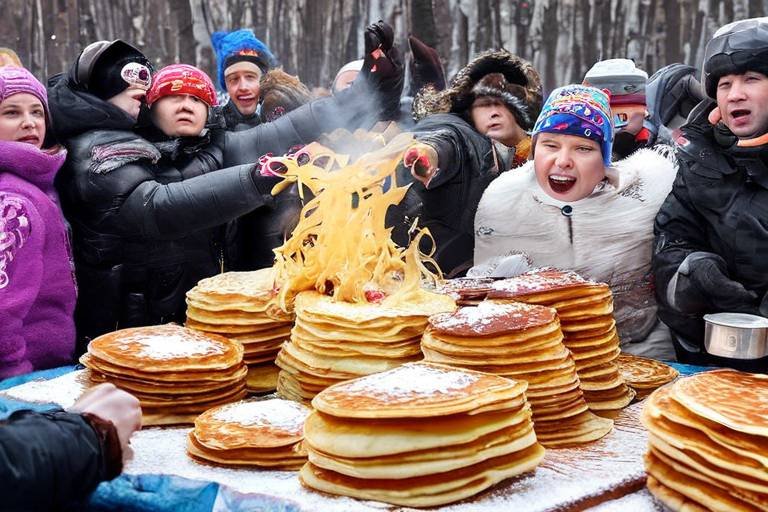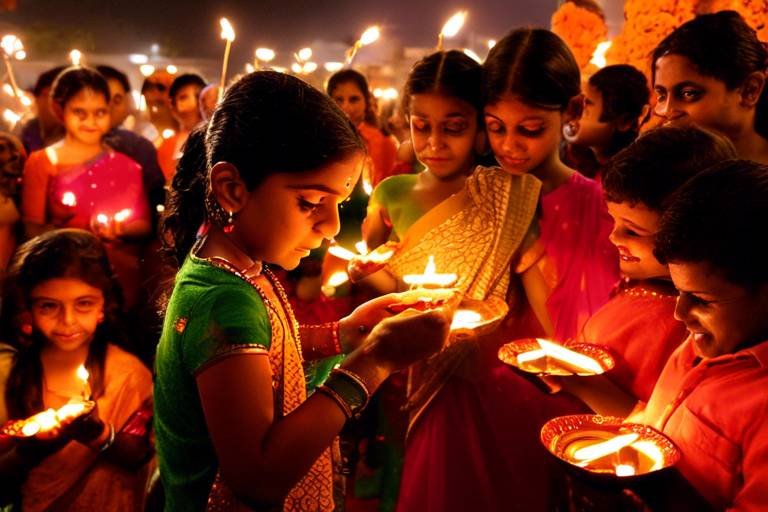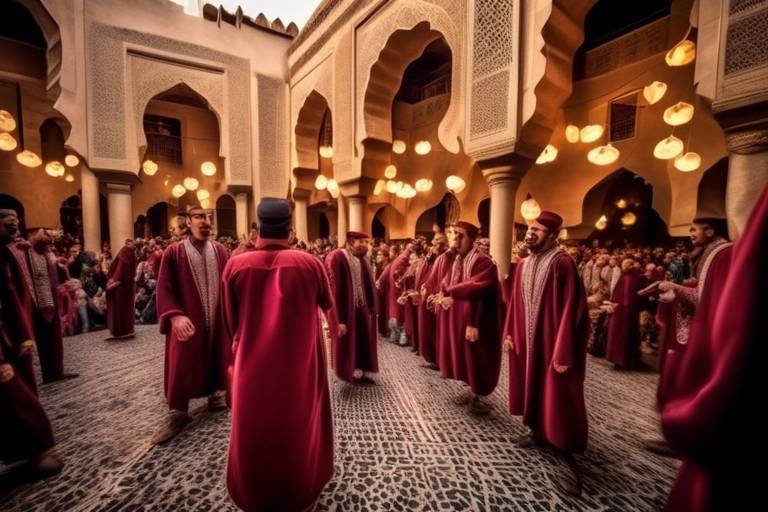The Vibrant Traditions of India's Durga Puja
India's Durga Puja is a vibrant and colorful festival that holds immense cultural significance in Hindu traditions. The festival is a grand celebration honoring the goddess Durga, known for her strength and power. It brings together communities in joyous festivities filled with rituals, decorations, feasting, and a strong sense of togetherness.

History and Origins
Delve into the rich tapestry of history and mythology that surrounds the vibrant festival of Durga Puja. The origins of this grand celebration can be traced back to ancient Hindu scriptures and legends, where the goddess Durga is depicted as a powerful deity who embodies courage, strength, and divine femininity. According to mythological accounts, Durga was created by the combined energies of various gods to defeat the demon Mahishasura, symbolizing the triumph of good over evil.
Over the centuries, Durga Puja has evolved into a significant cultural event that holds deep religious significance for Hindus across India and beyond. The festival is not just a time for worship and devotion but also a period of joyous festivities and community bonding. It brings together people from all walks of life, transcending social barriers and fostering a sense of unity and togetherness.
The history of Durga Puja is a fascinating journey through time, reflecting the cultural heritage and spiritual beliefs of the Indian subcontinent. From its humble beginnings as a local celebration to its current status as a major festival observed with grandeur and fervor, Durga Puja has stood the test of time, preserving its essence while embracing modern influences.

Preparations and Planning
When it comes to for Durga Puja, the entire process is a meticulously organized affair that involves a myriad of tasks and arrangements. One of the key aspects of the preparation phase is the crafting of idols of the goddess Durga, which requires skilled artisans to meticulously sculpt and paint the intricate figures. These idols serve as the focal point of the festival, symbolizing the presence of the divine goddess among her devotees.
In addition to idol making, another crucial element of the preparations is the decoration of pandals, temporary structures that house the idols during the festival. These pandals are adorned with elaborate designs, colorful motifs, and thematic decorations that reflect the artistic creativity and cultural richness of the community. The process of decorating pandals often involves a collaborative effort among local artisans, decorators, and volunteers who work tirelessly to create a visually stunning and spiritually uplifting environment.
Furthermore, organizing cultural programs and events forms an integral part of the planning process for Durga Puja. From traditional music and dance performances to theatrical productions and art exhibitions, these cultural activities add a vibrant and festive atmosphere to the celebration. Committees and organizing bodies responsible for the festival meticulously plan the schedule of events, coordinate with performers and artists, and ensure that every aspect of the cultural program runs smoothly.
Moreover, food plays a significant role in the preparations for Durga Puja, with the offering of bhog (food offering) to the goddess and distribution of prasad (blessed food) among devotees. The preparation of elaborate feasts and traditional dishes requires careful planning and coordination to ensure that everyone partaking in the festivities is well-fed and nourished. The communal aspect of sharing meals and enjoying the culinary delights adds to the sense of togetherness and camaraderie during the festival.
Overall, the preparations and planning involved in organizing Durga Puja are a testament to the dedication, creativity, and community spirit of the participants. From crafting idols and decorating pandals to organizing cultural events and feasting together, every aspect of the festival is infused with a sense of devotion and celebration that brings people together in joyous unity.

Rituals and Ceremonies
During Durga Puja, a myriad of rituals and ceremonies are meticulously performed, each holding deep symbolic significance in the worship of the goddess Durga. The festivities kick off with the 'Mahalaya,' a special prelude that marks the beginning of the countdown to the main event. This is followed by the 'Bodhon' ritual, where the goddess is traditionally welcomed into the mortal world, invoking her divine presence.
As the festival progresses, devotees engage in 'Pushpanjali,' offering flowers to the goddess while reciting sacred hymns. The 'Sandhi Puja' is a crucial juncture, occurring at the juncture of the eighth and ninth lunar days, signifying the divine battle between Durga and the buffalo demon Mahishasura. This intense moment is believed to be the most powerful time of the festival, where the goddess is worshipped with fervor and devotion.
The 'Ashtami Anjali' involves the offering of prayers and flowers to the goddess on the eighth day of the festival, seeking her blessings for prosperity and well-being. The 'Kumari Puja' is a unique ritual where young girls are worshipped as manifestations of the goddess herself, symbolizing purity and divinity.
The grand finale of Durga Puja culminates with the 'Sindoor Khela,' a vibrant ceremony where married women smear each other with vermillion, symbolizing marital bliss and the triumph of good over evil. The immersion of the idols, known as 'Visarjan,' marks the end of the festival, bidding farewell to the goddess as she returns to her celestial abode.

Art and Craftsmanship
Art and craftsmanship play a pivotal role in the vibrant tapestry of Durga Puja celebrations, showcasing the rich cultural heritage and creative prowess of artisans. The festival is a canvas for artistic expressions, with skilled craftsmen pouring their hearts into crafting intricate idols of the goddess Durga. These idols, often made from clay and adorned with exquisite details, symbolize the divine presence during the festivities.
Moreover, the decorations adorning the pandals where the idols are housed are a sight to behold. Elaborate themes are brought to life through meticulous attention to detail, with each pandal telling a unique story through its design. From traditional motifs to contemporary interpretations, the artistic flair on display captivates visitors and adds to the festive ambiance.
The craftsmanship extends beyond the idols and pandals to encompass a myriad of art forms. Skilled artists create stunning displays of alpana (decorative patterns), rangoli (colorful designs made from colored powders), and lighting arrangements that illuminate the night sky in a mesmerizing spectacle. These artistic endeavors not only beautify the surroundings but also infuse the atmosphere with a sense of reverence and joy.
Artisans, often belonging to generations of craftsmen, dedicate themselves to preserving and evolving the artistic traditions of Durga Puja. Their expertise and passion shine through in every creation, reflecting a deep-rooted commitment to honoring the goddess and enchanting the devotees. The fusion of art and craftsmanship during Durga Puja transcends mere aesthetics, serving as a testament to the cultural vibrancy and spiritual fervor that define this auspicious festival.

Cultural Significance
The of Durga Puja in India is deeply rooted in the country's rich heritage and traditions. This auspicious festival holds a special place in the hearts of millions of people, transcending religious boundaries and uniting communities in a spirit of joy and celebration. Durga Puja is not just a religious event but a cultural extravaganza that showcases the artistic talents, craftsmanship, and vibrant cultural diversity of India.
During Durga Puja, the entire country comes alive with colorful decorations, elaborate rituals, and festive fervor. It is a time of spiritual renewal and reflection, as devotees pay homage to the goddess Durga and seek her blessings for prosperity and well-being. The festival symbolizes the victory of good over evil, with the goddess Durga embodying strength, courage, and righteousness.
One of the most significant aspects of Durga Puja is the sense of community bonding and togetherness it fosters. People from all walks of life come together to organize the festival, build pandals, and participate in cultural programs. It is a time when social barriers are broken, and people of diverse backgrounds join hands in celebration.
The cultural significance of Durga Puja extends beyond religious rituals to encompass art, music, dance, and culinary delights. The festival is a showcase of India's rich cultural heritage, with artisans showcasing their skills through intricately crafted idols, vibrant decorations, and elaborate pandal themes. Traditional music and dance performances add to the festive atmosphere, filling the air with joy and exuberance.
Through its cultural significance, Durga Puja serves as a reminder of the values of unity, harmony, and community spirit. It is a time when people set aside their differences and come together to celebrate a shared heritage and tradition. The festival not only honors the goddess Durga but also celebrates the collective identity and cultural pride of the Indian people.

Festive Celebrations
The of Durga Puja are a sight to behold, filled with an electrifying energy that sweeps through the streets and hearts of devotees. The air is thick with excitement and anticipation, as the entire community comes together to honor the goddess Durga in a grand spectacle of colors and sounds. The celebrations kick off with vibrant processions, where beautifully adorned idols of the goddess are paraded through the streets amidst cheers and traditional music.
As the beats of the drums fill the air, the spirit of festivity engulfs everyone, transcending age, gender, and social status. Traditional dance performances, such as the energetic Dhunuchi dance, add to the lively atmosphere, captivating spectators with their grace and rhythm. The streets are transformed into a visual feast, with intricate decorations adorning every corner, creating a magical ambiance that is both enchanting and joyous.
One of the highlights of the Durga Puja celebrations is the cultural programs that showcase the rich heritage of Indian art and music. From classical music recitals to modern dance performances, the stage comes alive with talent and creativity, mesmerizing the audience and adding a touch of sophistication to the festivities. The evenings are filled with laughter, music, and the aroma of delicious food wafting from the bhog stalls, where devotees partake in the communal feast with gusto.
Amidst the revelry, the spirit of unity and togetherness shines brightly, as people from all walks of life come together to celebrate the triumph of good over evil. The sense of camaraderie is palpable, as neighbors, friends, and strangers join hands in joyous celebration, forging bonds that transcend barriers and differences. Durga Puja is not just a festival; it is a celebration of life, love, and the enduring spirit of community that defines the essence of Indian culture.

Regional Variations
India's diverse cultural landscape is beautifully reflected in the regional variations of Durga Puja celebrations. Each region adds its unique touch to the festival, creating a tapestry of traditions that showcase the country's rich heritage. In West Bengal, the heartland of Durga Puja, the festivities reach a crescendo with grand processions, intricately crafted idols, and elaborate pandal decorations that captivate onlookers. The state's love for art, music, and literature infuses the celebrations with a creative flair that is unparalleled.
Conversely, in the southern state of Karnataka, Durga Puja takes on a more traditional tone, with a focus on religious rituals and spiritual practices. The emphasis here is on prayer, meditation, and introspection, as devotees seek blessings from the goddess for prosperity and well-being. The pandals are adorned with simple yet elegant decorations, reflecting the region's understated charm and devotion.
Heading north to the state of Uttar Pradesh, Durga Puja is celebrated with great fervor and enthusiasm, blending local customs with the overarching theme of victory of good over evil. The festivities here are marked by colorful processions, lively music performances, and sumptuous feasts that bring communities together in joyous revelry. The spirit of unity and harmony shines through in every aspect of the celebrations.
Traveling to the eastern state of Odisha, one encounters a unique blend of tradition and innovation in Durga Puja celebrations. Here, the focus is on showcasing indigenous art forms, such as Pattachitra painting and Gotipua dance, alongside the worship of the goddess. The pandals are transformed into works of art, depicting scenes from mythology and folklore, creating a visual spectacle that mesmerizes visitors.
Finally, in the western state of Gujarat, Durga Puja takes on a vibrant and colorful avatar, infused with the region's love for dance and music. The festivities here are marked by energetic Garba and Dandiya Raas performances, where men and women come together to dance in rhythmic harmony. The pandals are adorned with intricate mirror work and vibrant fabrics, reflecting the state's rich textile heritage.

Community Engagement
Community engagement lies at the heart of Durga Puja celebrations, fostering a sense of unity and camaraderie among participants. This vibrant festival brings together local residents who actively engage in organizing the event and participating in various activities. From setting up colorful pandals to arranging cultural programs, volunteers play a crucial role in creating a festive atmosphere that resonates throughout the community.
One of the key aspects of community engagement during Durga Puja is the spirit of volunteerism that motivates individuals to contribute their time and skills towards the successful execution of the festival. Whether it's preparing delicious bhog for offerings or coordinating traditional music and dance performances, the collective effort of volunteers enhances the overall experience for attendees and strengthens the bonds within the community.
Moreover, Durga Puja serves as a platform for fostering social connections and building lasting relationships within the neighborhood. The collaborative nature of the festival encourages people from diverse backgrounds to come together, share experiences, and celebrate the spirit of togetherness. Through joint efforts and shared experiences, participants not only create memorable moments but also forge deeper connections that extend beyond the duration of the festival.
Community engagement during Durga Puja extends beyond the festive rituals and cultural activities, encompassing initiatives that benefit the society at large. Many Puja committees undertake charitable projects, such as organizing health camps, educational programs, or environmental initiatives, to give back to the community and make a positive impact on the lives of those in need. These endeavors exemplify the altruistic spirit that underpins the festival and reinforces the values of compassion and social responsibility.
Frequently Asked Questions
- What is Durga Puja?
Durga Puja is a major Hindu festival that celebrates the victory of the goddess Durga over the demon Mahishasura. It is a time of feasting, dancing, and cultural performances to honor the divine feminine energy.
- When is Durga Puja celebrated?
Durga Puja usually takes place in the autumn months of September or October, following the lunar calendar. The festival lasts for about 10 days, culminating in the immersion of Durga idols in rivers or water bodies.
- What are the main rituals of Durga Puja?
Some of the key rituals of Durga Puja include the installation of Durga idols in pandals, offering prayers and bhog to the goddess, performing aarti (ritual worship), and immersing the idols in water as a symbolic farewell to the goddess.
- How is Durga Puja celebrated in different regions of India?
Durga Puja is celebrated with unique customs and traditions in various parts of India. For example, in West Bengal, it is a grand affair with elaborate pandals and cultural programs, while in other states, it may be observed in a more traditional manner.
- What is the significance of Durga Puja in Indian culture?
Durga Puja holds immense cultural significance in India as a time of spiritual renewal, community bonding, and festive joy. It brings people together, transcending religious boundaries and fostering a sense of unity and togetherness.



















